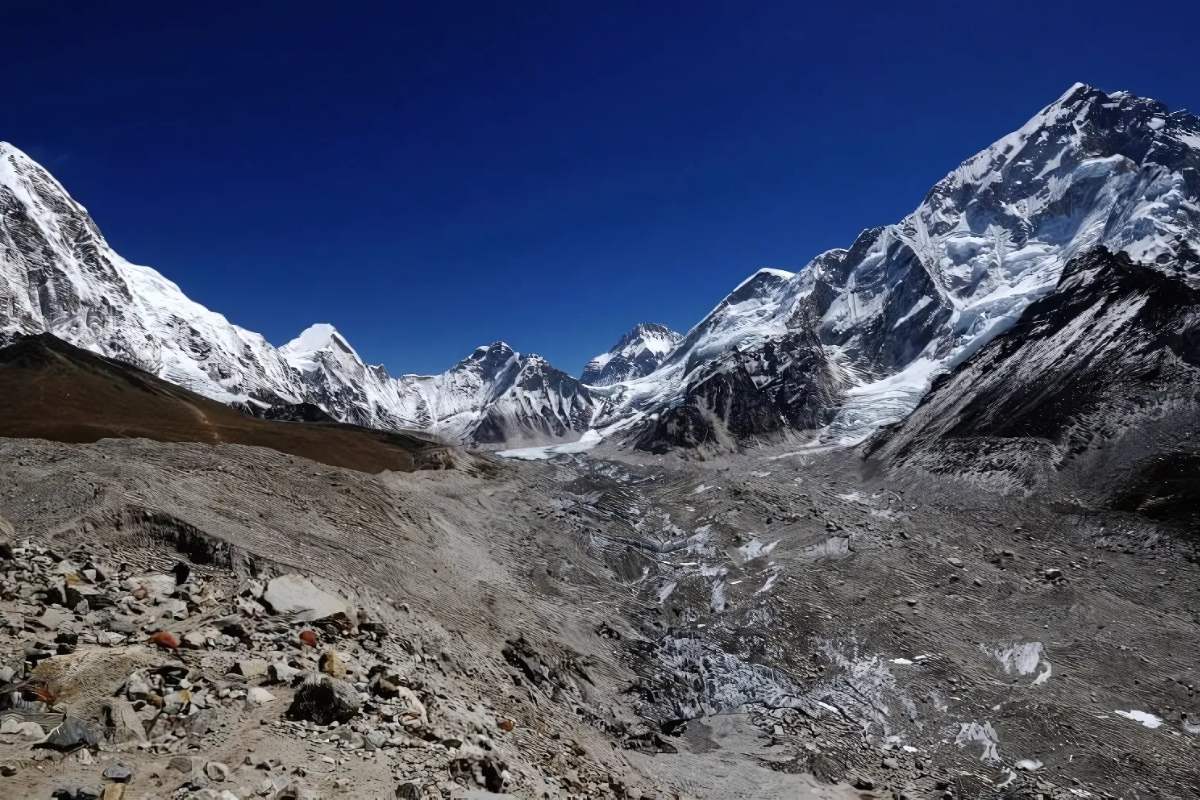Experts warned over the past few years that the ecological vulnerability of the Himalayas was increasing at a rapid pace. The Himalayas, also referred to as the “Third Pole,” contain the largest reserves of ice on our planet outside polar areas. Warming temperatures, however, combined with uncontrolled development, are undermining this frozen crown. Climate scientists note that the region has already warmed by over 1.3 °C since the mid-20th century, causing snow to shrink and glaciers to recede. India’s environment ministry has highlighted how retreating glaciers and human pressures are depleting water levels in the Himalayan rivers. This affects downstream water supplies, agriculture, and millions of livelihoods. We must understand what is driving Himalayan ecological vulnerability and how it can be reduced.
The high snow fields and towering mountains of the Himalayas render them especially vulnerable. The special geology and ecology of the Himalayas render the region severely vulnerable to climate change. Glaciers melt due to rising heat and changing weather patterns, while steep slopes increase the force of floods and landslides. Meanwhile, human activities – spreading farms, roads, hydropower, and tourism – are imposing stress on the vulnerable environment. Population increase and unchecked development in these high mountains are putting pressure on water and forest resources. All these combined are the underlying causes of Himalayan ecological vulnerability, and they pose a threat not only to the high-altitude ecosystems but to those who rely upon them.
Causes of Himalayan Ecological Vulnerability
- Climate warming and change. The most important driver of Himalayan vulnerability is a changing climate. The temperature in the region has increased significantly. This rate is far higher than the global average, particularly in mountainous regions. Melting glaciers and snow occur at an accelerated rate with warmer air. Himalayan glaciers are reducing at record rates, according to a study. Numerous glaciers will lose as much as 80% of their ice by 2100 if emissions continue at current levels. The lower flows of dry-season rivers, resulting from reduced glacier ice, threaten irrigation, hydropower, and urban water supplies in South and Central Asia. Himalayan glacier melting may change the rivers that supply water to more than a billion individuals.
- Shifts in precipitation patterns. In addition to increased temperatures, the Himalayas experience changes in rain and snowfall. Rising snowlines result in less winter snow at lower elevations and greater rain in some areas. Altered monsoon behavior has resulted in more intense downpours for shorter durations. These heavy rains saturate slopes and cause floods and landslides. There have been more frequent extreme downpours in the mountains in recent years. The outcome is an increased threat of flash floods. Sudden Glacial Lake Outburst Floods (GLOFs) have poured walls of water down valleys, inundating houses and facilities. This is characteristic of the way climate-attributable meltwater and heavy precipitation mix to render Himalayan rivers more unpredictable.
- Land-use change and deforestation. Humans are modifying the Himalayan environment more rapidly than it is able to recover. Forests have been cut down for farming, mining, and roads, lowering the natural resilience of the land. Himalayan roads and villages are frequently constructed on slopes where forest roots anchored the soil. Removing forest cover from steep slopes raises erosion and landslide danger. Uncontrolled development in numerous valleys has broken up wildlife habitat and upset watershed stability. This human trace amplifies each storm: without plant life to soak up rain, floods are more flashy and soils erode.
- Uncontrolled development and tourism. Large projects in the mountains – roads, dams, resorts – typically go ahead with weak environmental protections. The terrain of the Himalayas is geologically complex: numerous towns are located on old landslide deposits or loose glacial material. Subsidence and cracking have also been exacerbated by poor foundations and heavy building on unstable terrain. Leaking water from such projects further destabilizes the ground, speeding up sinking. Unchecked widening of settlements and roads has caused even slight quakes or rains to become fatal. Over-tourism also strains the limited water supply and garbage disposal. In short, much Himalayan development planning has ignored the fragile ecology.
- Population pressure and overuse. The population of the Himalayan states has expanded in leaps and bounds. Mountain valleys with little flat ground have dense populations. This density stresses limited resources. Farmers tend to over-use marginal land, and grazing animals strip grasslands bare. Water is diverted for irrigation, and groundwater is taken in large quantities, sometimes to supply hotels and resorts. This imbalance between increasing demand and diminishing natural supply highlights the human-imposed aspect of ecological vulnerability.
Effects of Himalayan Ecological Vulnerability
Himalayan ecological vulnerability is already yielding harsh effects. Glaciers are receding, lakes in mountains are increasing in number, and extreme events are becoming increasingly devastating. All these alterations impact millions of individuals.
- Shrinking glaciers and an increased number of glacial lakes are one of key effects. Melting ice creates lakes bounded by unstable debris. These lakes have grown hugely over the past decades. Along the Himalayas, new lakes are emerging where there was once ice. Most of these new lakes have developed in the last few decades, and this process is only going to continue. Each expanding lake is adding flood risk. When a moraine dam breaks, tens of millions of cubic meters of water suddenly can flow downstream. These events have resulted in fatalities and widespread destruction.
- Other effects result from melting. The water supply is altered. Short-term increases in river flow can result from more melting. But in the long term, less ice and snow result in lower summer baseflow. Rivers that have nourished great plains can dwindle in hot weather, endangering agriculture and drinking water. The Himalayas support rivers that supply about a quarter of the world’s population. Glacier losses could drastically reduce dry-season flows in these rivers by 2050. This endangers irrigation for crops on which hundreds of millions depend.
- More disasters and hazards are another symptom. As glaciers recede, they leave loose rocks and unstable slopes. The collapse of ice and rock into glacial lakes can trigger GLOFs far down the valley. Concurrently, heavier rainfall on arid slopes has caused lethal landslides and flash floods in large tracts of the Himalayas. In the past decade, the region has witnessed serious disasters entailing massive loss of life and property. These struck particularly the poorer mountain communities, who had made the smallest contribution to warming.
- Even everyday life today is transforming: old-fashioned mountain agriculture is more difficult, and there are fewer cultural connections to glaciers. The ice and snow of the Himalayas are a critical water source, offering ecosystem services to millions in the mountains and billions downstream. As this “Third Pole” cryosphere declines, people, agriculture, energy, and biodiversity will be hit on a grand scale.
Addressing Himalayan Ecological Vulnerability
In light of these dangers, immediate solutions must be found across all levels – local communities and world leaders. Specialists propose a multi-faceted method:
- Reduce greenhouse emissions: Most importantly, slowing down climate change by lowering the use of fossil fuels is necessary. Each degree of warming counts for the Himalaya glaciers and the millions who rely on them. Deep, quick emissions cuts globally can avoid the worst-case losses. Countries need to step up renewable energy and limit global warming to well below 2 °C.
- Enhance mountain water management: In high mountains, new water storage can alleviate shortages. For instance, Ladakh residents have long constructed ice stupas – dome-shaped manmade glaciers – every winter by channeling stream water into shaded pits. The stores of ice then melt gradually in spring, supplementing irrigation during the all-important growing season. The viability of these projects implies that they could be scaled up. Likewise, building small reservoirs and rainwater harvesting structures in mountain valleys can capture monsoon run-off. Regional collaboration is essential: rivers flow across international borders, and therefore, Himalayan countries ought to exchange information and synchronize dam releases and glacier monitoring. Improved water management in the region can moderate water release and enhance supply during dry periods.
- Control and plan infrastructure: building codes and land-use planning have to be imposed in the Himalayas. Development schemes must go through rigorous environmental testing. Risk areas – landslide or earthquake-risk slopes – should be marked and development restricted. Several Himalayan states have now announced no-construction areas surrounding glaciers or along steep slopes. Cities should be reconstructed “built back better” using disaster-resistant designs. Moreover, limiting unplanned tourism can ease the pressure. Governments should also track and mitigate ongoing risks: establishing early warning systems for floods and landslides, and periodic surveying of glacier lakes.
- Ecosystem restoration: Forest protection and restoration on the slopes can help prevent landslides and erosion. Replanted with local trees, it stabilizes soil and retains moisture. Terracing and perennial agroforestry are practiced by some mountain villages to make agriculture more climate-resilient. Communities and organizations are also restoring forests in degraded alpine meadows. These nature-based solutions both sequester carbon and protect against extreme events.
- Community adaptation and resilience: Local citizens have to be placed at the core of resolutions. Initiatives to train and educate Himalayan communities in disaster prevention are essential. Enabling local agriculture can enhance food security. Organizing mountain institutes and engaging youth in conservation ensures long-term stewardship. Micro-insurance programs for farmers and construction workers can offer safety nets against climate loss. Assistance must go to the poorest mountain communities, who bear the burden of ecological transformation.
These efforts need coordination both within nations and across borders. The Himalayan environment doesn’t end at national borders. Global platforms and emerging regional agreements can promote common approaches. The mountains need protection to safeguard humanity and the Earth.
Conclusion: Act Now to Protect the Third Pole
The fragile Himalayan environment is near a point of no return. Decades of information and recent catastrophes leave no doubt: Himalayan ecological susceptibility is real and increasing. Climate change and human activities are degrading the ice and soils that millions rely upon. But the future is not set. We have time yet if we act rapidly – reducing emissions, enhancing resilience, and recovering nature. Each degree of warming prevented will count for Himalayan glaciers, and for the more than a billion people who depend on their water.
The stakes are too high to be overstated. We risk permanent loss to the Himalayas. Governments, communities, and individuals must make it happen. Small things now – from planting a tree to arguing new policies for the mountains – make a difference. By learning the reasons and implications behind Himalayan ecological vulnerability, we can make well-informed decisions. The Third Pole should not fall victim to complacency. Saving the Himalayas is saving lives for millions of those below.






















